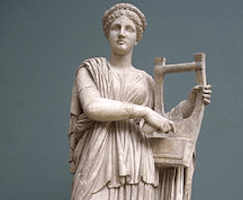 In Greek Mythology, it is said that the Nine Muses were responsible for all manner of creative and intellectual thought that took place in Ancient Greece. They are referred to throughout history in the writings of many individuals, such as in the works of Heisod and Diodorus Siculus. Once the Romans adopted elements of Greek mythology, they also embraced the story of the muses.
In Greek Mythology, it is said that the Nine Muses were responsible for all manner of creative and intellectual thought that took place in Ancient Greece. They are referred to throughout history in the writings of many individuals, such as in the works of Heisod and Diodorus Siculus. Once the Romans adopted elements of Greek mythology, they also embraced the story of the muses.
Each of the muses were responsible for one aspect of creative or intellectual thought, and Erato was the ancient muse of love poetry and songs, as well as poetry and songs about marriage. Here’s more information about who this muse is and what she stands for:
Basic Information About Erato
Like the other eight muses, Erato is said to be the daughters of Zeus and Mnemosyne. According to legend, Zeus and the titaness coupled for nine days in a row, and each of these nine days resulted in the conception of one of the muses. Her name means, either “desired” or “lovely” and this is evidenced in how she is usually depicted. She is most often shown wearing a wreath that is made from myrtle and roses and is also considered to be both passionate and erotic. She is also rarely shown standing up and is most often seated in her pictures. Like the rest of the muses, Erato is depicted as being a young and beautiful maiden whose very appearance inspires the love poetry.
Evidence of Erato in Literature
Erato is mentioned several times in various works of literature. For instance, Appolonius of Rhodes mentions that it could be derived from the same root in his work, Argonautica. In fact, Appolonius is the one who suggested that the name Erato may be derived from the same root as Eros and he also said that she had the grace of Aphrodite. In the works of Simon Vouet, he says that turtle doves are always at her feet, eating seeds. Turtle doves are one of the universal symbols of love. Also in Vouet’s work, he often depicts Eros, the god of love, as accompanying her.
Hesiod also mentions her in his Theogony work, along with the other eight muses. She was also mentioned in one of his lost poems, Rhadine, which was quoted in a work by the writer, Strabo. Plato also paired her with thoughts of love in his work, Phaedrus. She was also mentioned briefly in Virgil’s Aeneid.
Erato is one of the nine muses and she usually represents all writings that have to do with love, including love poetry, songs about love, and all topics related to love and marriage. Because of what she represents, she is also considered to be one of the most beautiful of all the muses, especially because it is said that her very appearance inspires these thoughts. In other words, whenever the ancient Greek writers and poets wanted to express love, Erato was usually present.
Sources:

